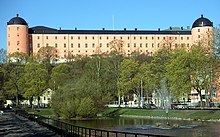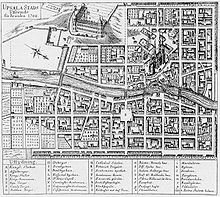Uppsala Castle
Uppsala Castle was originally started under Gustav Wasa . The hill south of the then city with the river Fyrisån at its feet was chosen as the building site. According to tradition, the foundation stone was laid for this in 1549, but the actual work had already started in 1547.
In 1548 work began on the southwest tower. Henrik von Cöllen, who had previously directed the work at Gripsholm Castle , was in charge of the construction .
He was followed in 1550 by Pavel Schütz, who expanded the castle and built a large outer bailey to the north. He also built two bastions and built a wall around the entire complex. At that time, the castle was not in its current north-south orientation, but in an east-west orientation. Only a few remains of this construction phase can be found today, e.g. B. the wall on which the wooden bell tower stands.
In 1572 the castle was badly damaged in a fire. Johann III. then gave Franz Parr (also Franziskus Pahr ) the order to rebuild the burned down castle. Parr was recruited from Mecklenburg . He had previously designed Güstrow Castle there, and in Uppsala Castle you can still find some details that resemble Güstrow Castle, such as: B. the King Jan Gate. The most elegant room in the palace at that time was the church. It took up three floors and included the throne room in it. Today, however, only a few stucco ornaments remain. The east tower was not finished when Parr died in 1580.
The construction progressed in the time of Charles IX. and Gustav II Adolf continue to advance. During this time, the so-called long lock was built, which stretched from the eastern turn to the north. The north tower, which was completed in 1614, formed the end. Gustav Adolf's daughter and successor Christina abdicated on June 16, 1654 at a Diet in Uppsala Castle; Her successor was her cousin Karl X. Gustav from the Wittelsbach family (Pfalz-Zweibrücken-Kleeburg).
In 1665 the palace garden began to be laid out. Today the Botanical Garden is located here. On May 16, 1702 the castle burned down again, this time on the train of the great fire that struck all of Uppsala . Restoration of the castle was considered impossible, so the bricks from the remaining walls were used to build the hospital in Uppsala and the City Palace in Stockholm . The southwest tower was torn down in the following period. It was not until 1744 that Hereditary Prince Adolf Friedrich decided to restore the remaining parts of the palace.
The work lasted from 1749 to 1762. During this time the long castle and the northern tower were restored. However, work stopped completely after 1762, before the southern tower was finally completed between 1815 and 1820. It was used as a prison until 1866 .
A wooden bell tower with a bell, which Queen Gunilla had cast in 1588, has been on a wall remnant since 1756. This bell is also used in connection with Valborg .
Since the beginning of the 20th century, the castle has housed various facilities of Uppsala University , an art museum and also the apartment of the District President of Uppsala Province . In 1935 the castle was placed under state protection as Byggnadsminne .
Web links
- Entry in the bebyggelseregistret des Riksantikvarieämbetet (Swedish)
Coordinates: 59 ° 51 ′ 12 ″ N , 17 ° 38 ′ 7 ″ E

